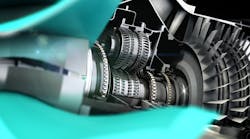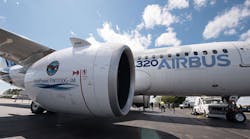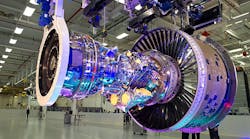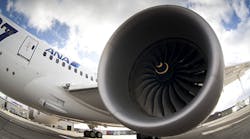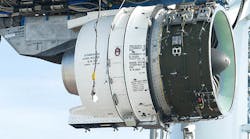Rolls-Royce Civil Aerospace operated the power gearbox of its forthcoming UltraFan™ engine for the first time, a design that the jet-engine OEM calls “the world’s most powerful aerospace gearbox.” The test run of the Rolls-Royce Power Gearbox (PGB) took place in Dahlewitz, Germany, and marks the start of a series of tests that will see the gearbox reach up to 100,000 horsepower.
UltraFan is one of two new turbofan jet engine designs that Rolls-Royce announced three years ago, aiming for better fuel efficiency and lower emissions. The UltraFan will be Rolls’ first engine platform to adopt "geared turbofan technology" (GTF.) It plans for UltraFan to come to market in 2025, providing at least 25% more fuel-efficiency than the first generation of its current Trent engines.
The power gearbox is what allows the engine design to achieve efficient power over a wide range of takeoff thrusts.
“This is another significant step in bringing our future technology to life,” according to Rolls-Royce chief engineer Mike Whitehead, who heads the UltraFan Technologies program. “We launched the UltraFan design in 2014, and now we are putting our new infrastructure to work to turn it into reality.”
Rolls-Royce is in partnership with Liebherr-Aerospace (they have a joint-venture company, Aerospace Transmission Technologies) to develop manufacturing capability and capacity for the new gearbox. Rolls-Royce handles design definition and integration for the power gearbox, as well as testing activities.
Geared turbofan engines are designed with a gear system separating the engine fan from the low-pressure compressor and turbine, so that each module operates at optimal speed, reducing fuel consumption, emissions, and engine noise.
Other design aspects of the UltraFan noted by Rolls-Royce include a new core architecture that will maximize fuel-burn efficiency and lower emissions; carbon-titanium (CTi) fan blades and a composite engine case, to reduce weight; and ceramic-matrix composite parts to establish greater heat resistance, and promote engine efficiency by requiring less cooling air.
The first run took place on Rolls-Royce’s Attitude Rig, which allows engineers to simulate the in-flight effects on a wing-mounted gearbox during the climb after takeoff, banking during flight, or coming in to land. The initial run confirmed rig dynamics and oil system functionality at low pressures and speeds.
More advanced testing will take place in the coming weeks to provide additional data on low-power/high-speed combinations at various pitch-and-roll angles, and at different simulated altitudes.
High-power testing will take place next year on the PGB Power Rig, wherein the gearbox will reach full power.
